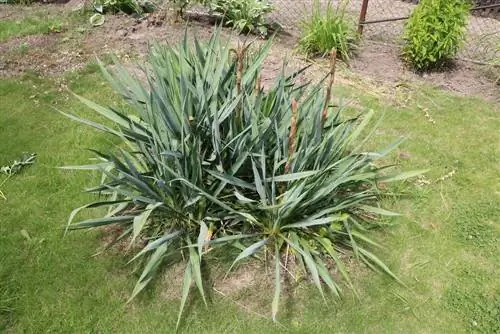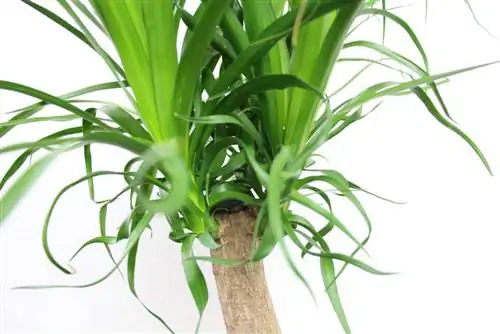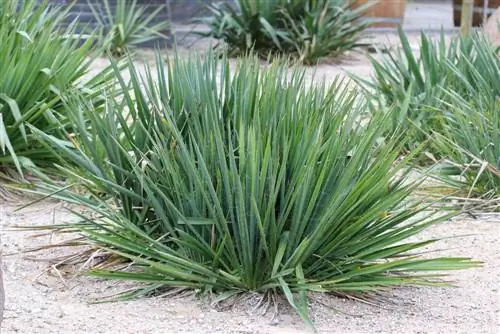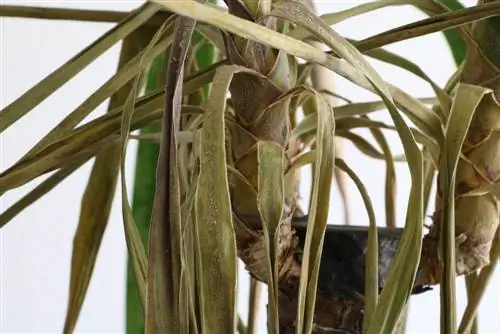- Author admin [email protected].
- Public 2023-12-17 03:39.
- Last modified 2025-01-24 12:45.
Palm trees are not exactly at home in Central European gardens, they just prefer tropical temperatures. The candle palm lily is not a “real” palm tree, but it does have a palm-like appearance. That's why it's often planted in the garden and creates a little holiday feeling. If cared for well, it will even bloom after a few years, making it look even more exotic.
The right location
In the southeastern United States, the climate is mostly sunny, warm, and dry. That's exactly how Yucca gloriosa likes it. So it needs a warm, sunny and dry location. It thrives best there.
The best soil
The candle palm lily does not tolerate wet soil or waterlogging. It absolutely needs a rather dry and well-drained, preferably sandy soil. If your garden soil is too heavy or too clayey, mix some fine gravel or sand into the soil. This loosens the soil. It can also be rather lean, the Yucca gloriosa does not have a high nutritional requirement.
Planting and transplanting
You can plant the candle palm lily throughout the entire growing season, from spring to autumn. It is very suitable as a solitary plant but also for small groups of around three plants. However, you should maintain a sufficiently large planting distance here, because the Yucca gloriosa will later become quite large and sprawling. You should calculate around 60 to 80 centimeters as the minimum distance.
Care
The Yucca gloriosa is not exactly high-maintenance, but it reacts very sensitively to any kind of moisture, even if it comes from above, from rain or from excessive watering. However, there are some breeding forms that cope better with wet conditions.
Tip:
If you live in an area with a lot of rainfall, then be sure to give your candle palm lily some protection from the rain, as it will die if it is excessively wet. Alternatively, buy a cultivated form that is less sensitive to moisture.
Pouring
You should only water a Yucca gloriosa a little, it is used to drought. Only water the candle palm lily well immediately after planting. This means that the soil is washed up to the roots and the plant roots more quickly.
Fertilize
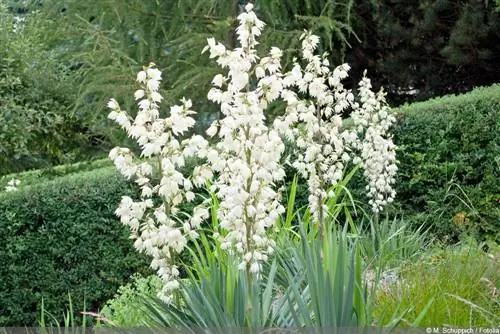
Fertilizing is usually not necessary for candle palm lilies outdoors because most garden soils contain enough nutrients. If your soil is particularly poor, give your Yucca gloriosa a little perennial fertilizer or well-rotted compost in the first year after planting. But use the fertilizer sparingly, because a candle palm lily is quickly over-fertilized and that's not good for it.
Cutting
The Yucca gloriosa does not need pruning. However, it is recommended to cut off the dried inflorescences. This is primarily for optics. Every now and then some leaves dry up. You can also remove these without hesitation. Since the leaves have quite sharp edges, it is better to wear gardening gloves when doing this work. It is also recommended to cut the leaves and not tear them off.
Propagate
Propagation of Yucca gloriosa is extremely easy because it forms offshoots itself. You just have to take this off, ideally in the fall. Fill some flower pots with a mixture of soil and sand and plant the cuttings in them. The young plants should overwinter indoors; they cannot yet tolerate frost. In spring you can plant the small candle palm lilies outdoors. But wait until the temperatures there have risen to around 20 °C.
The growth
The candle palm lily grows rather slowly and initially does not form a trunk but only a rosette of leaves with sturdy sword-shaped leaves that are reminiscent of palm leaves. The grey-green to blue-green leaves are around 30 to 50 cm long and have relatively sharp tips. Only after several years does the Yucca gloriosa develop a trunk up to two meters high.
The heyday
The candle palm lily only blooms after several years, but it is worth waiting for the exotic blooms. Fragrant bell-shaped flowers with a diameter of approx. 2 to 3.5 cm form on flower spikes that are around 50 cm to 1.4 m long. The flowers are usually white to greenish, but other flower colors can also occur in cultivated forms. The flowering time is in late summer or autumn.
Diseases and pests
Diseases and pests rarely occur with the candle palm lily because it is very robust. The greatest danger comes from the combination of waterlogging and severe frost. The lily hen also occasionally appears. This is a small red beetle that can cause a lot of damage by eating leaves.
Is Yucca gloriosa hardy?
The candle palm lily is native to southeastern North America and is therefore more accustomed to warmth and sun than to low temperatures and cold winters. Nevertheless, it can tolerate frost down to around -20 °C without special protection. However, she doesn't particularly like wetness, even in the cold season. It therefore does not always survive cold, wet northern German winters. Dry frost, on the other hand, is rarely a problem.
Is the candle palm lily suitable for planting in containers?
You can also cultivate a candle palm lily in a bucket or a large flower pot. Since it generally grows quite slowly, it has enough space there for several years. You can beautify your balcony as well as your terrace with a Yucca gloriosa. However, these should be positioned so that your candle palm lily is in the sun for several hours a day.
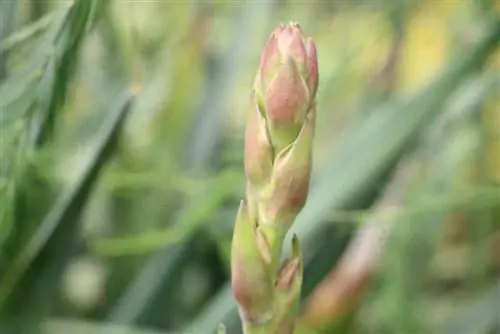
Be sure to plant your candle palm lily in planters that are sufficiently heavy so that it cannot tip over in windy conditions and use a mixture of potting soil and sand. The bottom of the container should have a drainage hole for excess irrigation water and a drainage layer to prevent the hole from becoming clogged with soil. The candle palm lily grows slower in the pot and does not reach the same height as it does outdoors, even when it is older.
How do I care for a candle palm lily in a pot?
In terms of care, potted and outdoor plants hardly differ. However, the potted plant needs some fertilizer during the vegetation phase because the supply of nutrients in the planter is naturally limited. Give your Yucca gloriosa a tiny dose of perennial fertilizer regularly from May to August. Repot the plant about every two to three years, ideally in spring (March or April). The time to repot is at the latest when the plant becomes unstable due to its growth and the pot threatens to tip over or when the roots of your candle palm lily are already growing out of the container. Then choose a slightly larger pot.
How do I overwinter a candle palm lily in a pot?
You can either overwinter your candle palm lily in a pot outside, well protected, or in a cool winter quarters. Outside, you absolutely have to protect the root ball from freezing. Since frost can reach the roots from all sides, protection from below is also necessary. Wrap the entire planter with an old blanket, several jute bags or bubble wrap. Additionally, place the container on a wooden or Styrofoam plate. Make sure your Yucca gloriosa doesn't get its feet wet. It is best to place the plant protected from rain and wind.
Overwintering in the winter quarters
If your candle palm lily is still small and relatively manageable, you can also move the plant to winter quarters. This should be cool but frost-free most of the time. For example, a cool winter garden or a greenhouse is suitable; a dark basement room is less suitable. The Yucca gloriosa should survive short periods of frost with temperatures that are not too low without any problems, even in the pot. In winter the plant is not fertilized at all and watered very little.

